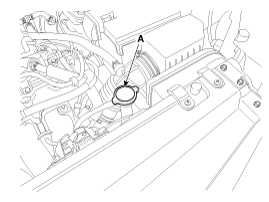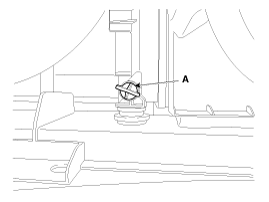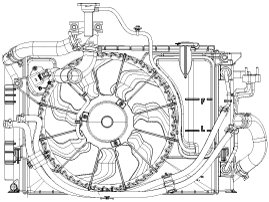 Kia Soul: Cooling System Refilling And Bleeding
Kia Soul: Cooling System Refilling And Bleeding
Kia Soul 2014-2019 PS Service Manual / Maintenance / Power Train / Cooling System Refilling And Bleeding
Never remove the radiator cap when the engine is hot. Serious
scalding could be caused by hot fluid under high pressure escaping from
the radiator.
|
When pouring engine coolant, be sure to shut the relay box lid
and not to let coolant spill on the electrical parts or the paint. If
any coolant spills, rinse it off immediately.
|
| 1. |
Make sure the engine and radiator are cool to the touch.
|
| 2. |
Remove radiator cap (A).
|
| 3. |
Remove the engine room under cover.
(Refer to Engine And Transaxle Assembly - “Engine Room Under Cover”)
|
| 4. |
Loosen the drain plug (A) and drain the coolant.
|
| 5. |
Tighten the radiator drain plug securely.
|
| 6. |
After draining engine coolant in the reservoir tank, clean the
tank.
|
| 7. |
Fill the radiator with water through the radiator cap and tighten
the cap.
|
| 8. |
Start the engine and allow to come to normal operating temperature.
Wait for the cooling fans to turn on several times. Accelerate the engine
to aid in purging trapped air. Shut engine off.
|
| 9. |
Wait until the engine is cool.
|
| 10. |
Repeat step 1 to 9 until the drained water runs clear.
|
| 11. |
Fill fluid mixture with coolant and water (55~60%) (except for
North America, Europe and China: 45~50%) slowly through the radiator
cap. Push the upper/lower hoses of the radiator so as bleed air easily.
|
| 12. |
Start the engine and run until coolant circulates. When the cooling
fan operates and coolant circulates, refill coolant through the radiator
cap.
|
| 13. |
Repeat step 12 until the cooling fan 3 ~ 5 times and bleed air
sufficiently out of the cooling system.
|
| 14. |
Install the radiator cap and fill the reservoir tank to the "F"
line with coolant.
|
| 15. |
Run the vehicle under idle until the cooling fan operates 2 ~
3 times.
|
| 16. |
Stop the engine and wait coolant gets cool.
|
| 17. |
Repeat step 11 to 16 until the coolant level doesn't fall any
more, bleed air out of the cooling system.
|
 Cooling System Inspection
Cooling System Inspection
Radiator hoses
1.
Check radiator hoses for the following
(1)
Improper attachment
(2)
...
 Drive Belt Inspection
Drive Belt Inspection
1.
Check belt for maintenance and abnormal wear of V-ribbed part.
Replace if necessary.
...
See also:
Push-starting
Vehicles equipped with automatic transaxle lock system cannot be push-started.
Follow the directions in this section for jump-starting.
WARNING
Never tow a vehicle to start it because the sudden su ...
Roof Antenna Removal
1.
Disconnect the negative (-) battery terminal.
2.
Disconnect the roof antenna connectors (A).
...
Antenna Installation
1.
Connect the roof antenna connectors.
2.
Install the rear roof trim.
3.
Connect the negative (-) battery term ...





